Fact-Checker
In this lesson, students review examples of misinformation, identify a rumor pattern and create a list of red flags to watch out for. Then students will create a social media post warning others to be on the lookout for this type of misinformation and directing them to credible sources about the subject. Finally, students will discuss the impact of misinformation on a democratic society.
Intended for grades 3 and up, this lesson plan includes everything educators need to lead the lesson: essential questions, electronic materials, vocabulary, procedural directions, ideas for differentiation, checks for understanding, examples, an evaluation rubric, and ideas for an extension opportunity. Depending on the classroom, it could take between 30-60 minutes, or be broken up over a few class periods. At the News Literacy Project, we recognize educators are professionals and best understand the needs of their classroom. As such, we expect educators to take and adapt our resources, including this lesson plan, as they see fit.
Below is a preview of some of the elements in the lesson plan:
NLP standard 4: Students demonstrate increased critical habits of mind, including effective verification skills and the ability to detect misinformation and faulty evidence.
Essential Questions
- What are some different types of misinformation?
- What does it look like to be a responsible and news-literate participant in a democracy?
- If I see misinformation, how should I respond?
- How can misinformation and false beliefs undermine an individual’s participation in a democracy and threaten the political process?
- Can misinformation that other people believe still affect those who aren’t fooled by it?
Vocabulary
- Misinformation: Information that is misleading, erroneous or false. While misinformation is sometimes created and shared intentionally, it is often created unintentionally or as humor (for example, satire) and later mistaken as a serious claim by others.
- Viral rumor: An unsubstantiated claim that spreads widely on social media and elsewhere online. Viral rumors often use deceptive techniques (such as out-of-context or doctored images) to stir up strong emotions and amplify false or misleading ideas.
PitchIt! Student essay contest
PitchIt! Student essay contests happening in Colorado, Florida, New York, Pennsylvania and Texas
Grades: 6-8, 9-12
About
Student voices are catalysts for positive change in schools and communities. You can empower them to be well-informed and civically engaged when you participate in the News Literacy Project’s PitchIt! contest.
This is an authentic way to get middle and high school students to learn about and express their thoughts about current events from a news literacy perspective. In addition to exploring an issue important to them, they can help combat misinformation or work to protect freedom of the press.
To have your students participate in PitchIt! and get the most out of it, use NLP’s free resources and curriculum guides. You choose the top essays from your class to submit for judging and prizes.
Click here for a printable, one-page guide to participating in PitchIt!
It is the ideal time to start using Checkology® and other free resources to prep your students. You can also email your questions to [email protected] for more information.
- Pennsylvania deadline, March 1, 2024: Click here for details.
- Colorado deadline, April 15, 2024: Click here for details.
- Florida deadline, May 24, 2024. Click here for details.
- New York deadline, April 19, 2024: Click here for details.
- Texas deadline, April 26, 2024: Click here for details.
Not in one of these regions? NLP encourages you to contact your local news literacy ambassador or our staff ([email protected]) and adapt our contest rules to create a contest for your learning community.
Curious to what participating teachers had to say?
“PitchIt! utilizes news literacy curriculum to broaden the understanding of how media influences all of us every day. Students then analyze and learn for themselves the power of using information with and without bias. I highly recommend facilitating part or all of the curriculum in classrooms across the board in Social Studies, English, Science, and more. It shows students that language, facts, and biases impact us comprehensively.”
— Renee A. Cantave, iWrite magnet educator, Arthur and Polly Mays Conservatory of the Arts, Miami, Florida
“PitchIt! was a great experience for my students. Not only did it raise awareness among them regarding the importance of good writing and of an important current issue in our community, the culminating event gave contest winners a chance to verbally express their positions, while receiving important feedback.”
— Rolando Alvarez, Coral Way K-8 Center, Miami, Florida
Tired of feeling like you’re working in a vacuum? Sign up for NewsLitNation and our private NewsLitNation Facebook Group to connect and share with other educators across the country passionate about news and media literacy. As a member of NewsLitNation® you’ll receive special perks and the NewsLitNation Insider, our monthly newsletter that keeps you up to date about all things news literacy!
Evaluate credibility using the RumorGuard 5 Factors
Don’t get caught off guard. Recognize misinformation and stop it in its tracks by using RumorGuard’s 5 Factors for evaluating credibility of news and other information. This classroom poster displays the 5 Factors alongside “Knows” and “Dos” for evaluating credibility.
Learn about RumorGuard | Go to RumorGuard | The 5 Factors on RumorGuard
The 5 Factors
- Authenticity. Is it authentic?
The digital age has made creating, sharing and accessing information easier than ever before, but it’s also made it easier to manipulate and fabricate everything from social media posts to photos, videos and screenshots. The ability to determine whether something you see online is genuine, or has been doctored or fabricated, is a fundamental fact-checking skill.
- Source. Has it been posted or confirmed by a credible source?
Not all sources of information are created equal, but it can be easy to glaze over the significant differences while scrolling through feeds online. Standards-based news organizations have guidelines to ensure accuracy, fairness, transparency and accountability. While these sources aren’t perfect, they’re far more credible and reliable than sources that have no such standards. Viral rumors that confirm one’s perspectives and beliefs or that repeatedly appear in social media feeds can feel true, but if no credible source of information has confirmed a given claim it’s best to stay skeptical.
- Evidence. Is there evidence that proves the claim?
Misinformation lacks sound evidence by its very nature — but it often tricks people into either overlooking that fact or into accepting faulty evidence. Many false claims are sheer assertions and lack any pretense of evidence, while others present digital fakes and out-of-context elements for support. Evaluating the strength of evidence for a claim is a key fact-checking skill.
- Context. Is the context accurate?
Tricks of context are one of the most common tactics used to spread misinformation online. Authentic content — such as quotes, photos, videos, data and even news reports — is generally easy to remove from its original context and place into a new, false context. For example, an aerial photo of a sports championship parade from 2016 can easily be copied and reposted alongside a claim that it depicts a political protest that took place yesterday. In this false context, the photo may easily be perceived as genuine by unsuspecting people online. Luckily, there are easy-to-use tools that can verify the original context of most digital content.
- Reasoning. Is it based on solid reasoning?
Misinformation is often designed to exploit our cognitive biases and vulnerability to logical fallacies. These blind spots in our rational thinking can make baseless conclusions feel plausible or even undeniable — particularly when they reinforce one’s beliefs, attitudes and values. Conspiracy theorists, pseudoscience wellness influencers and propagandists commonly rely on flawed reasoning to hold their assertions together. Learning to logic-check claims is an important element in verifying information.
Know and do
Know:
• Standards of quality journalism
• Types of misinformation
• How cognitive biases work
• What makes evidence credible
Do:
• Reverse image search
• Lateral reading
• Critical observation
• Search internet archives
• Practice healthy skepticism
News Lit Quiz: Is it legit? Vetting news sources for credibility
News Goggles: Candice Norwood, The 19th*
News Goggles annotations and activities provide news literacy takeaways on timely topics. These resources feature examples of actual news coverage, including full news reports, headlines, breaking news alerts or excerpts.
This video originally appeared in the Feb. 7, 2022, issue of The Sift® newsletter for educators, which explores timely examples of misinformation, addresses journalism and press freedom topics and examines social media trends and issues. Read archives of the newsletter and subscribe here. Stock music in this video was provided by SoundKit from Pond5.
Breaking news involves coverage of an event that has just happened or is still happening. Details can change quickly as more information emerges. This week, we talk to journalist Candice Norwood about her role as a breaking news reporter at The 19th*, a nonprofit newsroom that reports on gender, politics and policy.
Norwood sheds light on her recent coverage of President Joe Biden reaffirming his pledge to nominate the first Black woman to the Supreme Court, following Justice Stephen Breyer’s retirement announcement. We discuss how The 19th* approaches breaking news with its mission in mind and examine how news organizations demonstrate credibility and transparency in their newsgathering for developing stories.
Norwood also offers tips on navigating breaking news, including approaching coverage with a critical eye, evaluating the sources cited in a news report and remembering to slow down.
“There’s no rush to post something,” she said.
Grab your news goggles!
Resources: “Practicing Quality Journalism” (NLP’s Checkology® virtual classroom) and “Tracking developing stories” (NLP’s News Goggles activity with classroom-ready slides).
Dig deeper: Use this viewing guide for the featured News Goggles video as students consider how a news organization such as The 19th* approaches breaking news coverage.
Have feedback about this resource? Or an idea for a future News Goggles? Please share it with us at [email protected].
How to speak up without starting a showdown
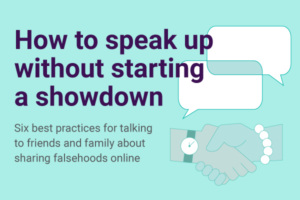 Misinformation is always problematic, but when it appears alongside pet photos and family updates on social media, it can be especially frustrating and unwelcome. It’s one thing if a stranger spreads falsehoods online. But what should we do when we see misinformation shared by family and friends?
Misinformation is always problematic, but when it appears alongside pet photos and family updates on social media, it can be especially frustrating and unwelcome. It’s one thing if a stranger spreads falsehoods online. But what should we do when we see misinformation shared by family and friends?
Stepping into the role of fact-checker when it comes to loved ones can be tricky and stir strong emotions, so it’s worth preparing for — especially as more falsehoods seep across social media and into family and friend group chats.
While every scenario is different, following some general best practices can help keep the conversation civil and make the interaction worthwhile. Use these six tips — with some helpful phrases for getting started — as a guide on how to speak up without starting a showdown. It may not be easy, but talking to loved ones about false or misleading content can help them think twice about what to share in the future.
News Goggles: Corrections and clarifications: Accuracy and correcting the record
News Goggles annotations and activities offer news literacy takeaways on timely topics. These resources feature examples of actual news coverage, including full news reports, headlines, breaking news alerts or excerpts.
This News Goggles resource originally appeared in a previous issue of The Sift newsletter for educators, which explores timely examples of misinformation, addresses journalism and press freedom topics and examines social media trends and issues. Read archives of the newsletter and subscribe here.
It’s a fear that can keep a journalist up at night: a factual error in a news report. Accuracy is paramount in journalism. Journalists at standards-based news organizations work to verify and fact-check each piece of information in their reporting. But what happens when occasional mistakes occur? Quality news organizations take factual inaccuracies very seriously. When journalists discover mistakes, they should correct the information as soon as they can and provide clear explanations.
Being transparent about mistakes — and accountable for them — is a key characteristic that separates credible news organizations from other sources of information. Let’s examine several news reports and consider how different news organizations handled corrections. Grab your news goggles. Let’s go!
★ Featured News Goggles resource: These classroom-ready slides offer annotations, discussion questions and teaching ideas related to this topic.
Note: New research reveals that Johns Hopkins, founder of the university and hospital that bear his name and long considered a “staunch abolitionist,” actually owned slaves, according to a Baltimore Sun news report. The reporting helps underscore the importance of correcting the historical record when new information comes to light — even decades later.
Discuss: Why is it important for news organizations to correct inaccuracies? How does correcting mistakes make a news source more trustworthy? How often do standards-based sources of news make errors of fact? What types of errors are the most common?
Idea: Ask students to research corrections policies and standards posted online for a few local news organizations. How do these policies compare? Do the policies outline how to contact the newsrooms about mistakes? Connect your students with one of NLP’s journalist volunteers using the Checkology journalist directory and have a conversation about errors and corrections. Discuss the steps the journalist takes to prevent corrections and correct factual inaccuracies.
Another Idea: Select one of the news reports included in the slides. To demonstrate the number of facts that journalists are verifying in a typical news report, ask students to tally the facts in the selected article. Be sure the students look for name spellings, job titles, organization names, dates, locations, quotes, etc. How would students go about fact-checking this report?
Resources: “Practicing Quality Journalism” (NLP’s Checkology® virtual classroom) and Newsroom to Classroom (NLP’s Checkology® directory of journalist volunteers).
Have feedback about this resource? Or an idea for a future News Goggles? Please share it with us at [email protected]. You can also use this guide for a full list of News Goggles from the 2020-21 school year for easy reference.
News Goggles: Can you trust it? Dolly Parton in People magazine
News Goggles annotations and activities offer news literacy takeaways on timely topics. These resources feature examples of actual news coverage, including full news reports, headlines, breaking news alerts or excerpts.
This News Goggles resource originally appeared in a previous issue of The Sift newsletter for educators, which explores timely examples of misinformation, addresses journalism and press freedom topics and examines social media trends and issues. Read archives of the newsletter and subscribe here.
After news broke on Nov. 16, 2020, that early data showed a vaccine from the drugmaker Moderna was nearly 95 percent effective, fans of American singer-songwriter Dolly Parton praised her $1 million donation to help fund COVID-19 vaccine research. Major news organizations including The Washington Post, The New York Times, CNN and BBC News covered the story.
But let’s imagine you came across this news online by seeing an article from People magazine. Can you trust it? Is People a credible source for news about this story? How do you know? In this edition of News Goggles, we’re going to examine sourcing and the use of hyperlinks in news reports as we consider what makes information credible. Grab your news goggles!
★ Featured News Goggles resources: These classroom-ready slides offer annotations, discussion questions and a teaching idea related to this topic.
Discuss: What makes a news source credible? When are hyperlinks important or useful to include? How can you fact-check information in a report that has been “picked up” from another news organization? Are magazines like People more or less reliable than news organizations like The New York Times? Considering the audience and purpose of each, which source do you trust more and why?
Idea: Ask students to read an online article from a standards-based news organization on a topic of their choosing, paying special attention to any hyperlinks in the text. Direct them to take notes on which details and phrases incorporate links, where each hyperlink leads and how its inclusion impacts the news report. (Does it add context? Lead to sources? Jump to previous coverage? Offer evidence or support?)
Resource: “Practicing Quality Journalism” (NLP’s Checkology® virtual classroom).
Have feedback about this resource? Or an idea for a future News Goggles? Please share it with us at [email protected]. You can also use this guide for a full list of News Goggles from the 2020-21 school year for easy reference.
“TRUST ME” discussion guide on manipulation and misinformation (collegiate guide)
 About the film
About the film
Misinformation is all around us, and it has real-world consequences. In today’s information landscape where anyone can publish almost anything, who — and what — can you trust?
“TRUST ME” is a feature-length documentary directed by Oscar-nominated Roko Belic that delves into the topics of manipulation and misinformation by exploring human nature, information technology, and the need for news and media literacy to help people trust one another. The film was produced by the Getting Better Foundation, whose mission is to build trust using the truth. For additional information about the film or its producers, or to get involved, go to the film’s website.
The film is available for purchase from New Day Films: “TRUST ME“.
About this guide
This guide was produced by the News Literacy Project (NLP) and Pamela Brunskill with support from the John S. and James L. Knight Foundation.
The guide is intended for adult learners in all settings, such as colleges, correctional facilities and community forums. Leaders should adapt, adopt and adjust these recommendations and ideas as they see fit.
The discussions we recommend are broken up into three sections: before viewing, during viewing and after viewing to help you establish, and build on, the core concepts in the film and reflect on the questions that result. Extension and further reading opportunities are listed at the end of the guide.
“TRUST ME” classroom guide: A unit on manipulation and misinformation
 About the film
About the film
Misinformation and disinformation are all around us, and have real-world consequences. In today’s information landscape where anyone can publish almost anything, who — and what — can you trust?
“TRUST ME” is a feature-length documentary that delves into the topics of manipulation and misinformation by exploring human nature, information technology, and the need for news and media literacy to help people trust one another. The film was produced by the Getting Better Foundation, whose mission is to build trust using the truth. For additional information about the film or its producers, or to get involved, visit TRUSTMEdocumentary.com and GettingBetterFoundation.org. The film is available for purchase from New Day Films.
The education cut of the film that accompanies this guide includes 15 segments. Depending on your schedule and objectives, you can show the full documentary or share it in segments.
About this guide
This guide was produced by the News Literacy Project (NLP) and Pamela Brunskill with support from the John S. and James L. Knight Foundation, which also funded the distribution of the education cut of the film.
The guide is intended for students in grades 4-6, 7-9, and 10-12+. The lessons are delineated for a particular grade band when appropriate and are designed for teachers to adapt, adopt, and adjust as they see fit.
The lessons are broken up into three sections: before viewing, during viewing and after viewing to allow for scaffolded development of concepts and understanding. Extension and further reading opportunities are listed throughout each of these sections.
“TRUST ME” discussion guide on manipulation and misinformation (for parents and caregivers)
 About the film
About the film
Misinformation is all around us, and it has real-world consequences. In today’s information landscape where anyone can publish almost anything, who — and what — can you trust?
“TRUST ME” is a feature-length documentary directed by Oscar-nominated Roko Belic that delves into the topics of manipulation and misinformation by exploring human nature, information technology, and the need for news and media literacy to help people trust one another. The film was produced by the Getting Better Foundation, whose mission is to build trust using the truth. For additional information about the film or its producers, or to get involved, go to the film’s website.
The film is available for purchase from New Day Films: “TRUST ME“.
About this guide
This guide was produced by the News Literacy Project (NLP) and Pamela Brunskill with support from the John S. and James L. Knight Foundation.
The guide is intended for parents and caregivers to aid in discussing the film with their families or other caregivers. They should adapt, adopt, and adjust these recommendations and ideas as they see fit.
The discussions we recommend are broken up into three sections: before viewing, during viewing and after viewing to help you establish, and build on, the core concepts in the film and reflect on the questions that result. Extension and further reading opportunities are listed at the end of the guide.
Seven standards of quality journalism
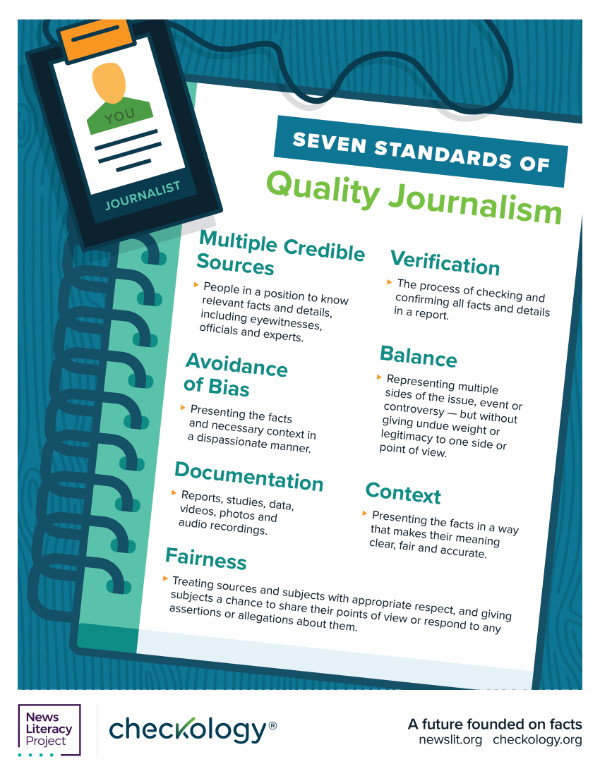
The standards and practices of quality journalism are complex, numerous and dynamic, and are implemented differently by different journalists and different news organizations under different circumstances on different pieces of journalism. See a trend here? Practicing journalism is complicated and nuanced. Still, the general purpose behind the standards is the same: to produce the most accurate, fair and useful information possible.
Some journalism standards are obligatory (such as the prohibition against making things up) and quantifiable (such as newsroom policies about the use of anonymous sources), while others are aspirational (such as the attempt to eliminate bias and to be as fair and accurate as possible) and require judgment and discussion to apply (such as assessing newsworthiness, evaluating sources and determining fairness).
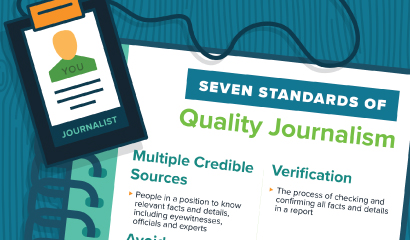 In almost all cases at major news organizations, these standards are subject to constant reconsideration and revision — whether to prevent the recurrence of an error or to adapt to new tools and methods of gathering and reporting information (for example, using social media to locate sources, or livestreaming breaking news events).
In almost all cases at major news organizations, these standards are subject to constant reconsideration and revision — whether to prevent the recurrence of an error or to adapt to new tools and methods of gathering and reporting information (for example, using social media to locate sources, or livestreaming breaking news events).
By introducing students to the major standards of quality journalism, and helping them understand their nature and rationale, you’re providing them with conceptual and analytical tools that they can use to evaluate the credibility of the information they encounter daily and, in some cases, to critically respond to it. This knowledge can also activate a wide variety of high-level news literacy discussions in your classroom and beyond.
The seven primary standards of quality journalism and their descriptions are included in the poster linked below. This poster is adapted from a highly interactive, immersive learning experience in our Checkology® virtual classroom in which students are placed in the role of a rookie reporter on the scene of a breaking news event and learn the standards of quality journalism by “covering” the story. They are guided by their editor and a veteran reporter back in the newsroom throughout the process, and can use their virtual notebooks to see their progress in following the standards. At the end of the lesson, they build the story, selecting the most appropriate headline, lead, image and more. Use this poster with the Checkology lesson “Practicing the Standards of Quality Journalism” or on its own.
How to know what to trust
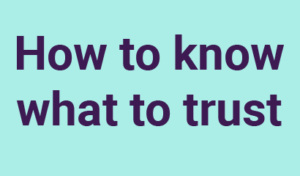 Misinformation comes at us every day, across many platforms and through a variety of methods. It’s all part of an increasingly complex and fraught information landscape. But what exactly do we mean when we say misinformation?
Misinformation comes at us every day, across many platforms and through a variety of methods. It’s all part of an increasingly complex and fraught information landscape. But what exactly do we mean when we say misinformation?
We define it as information that is misleading, erroneous or false. While misinformation is sometimes created and shared intentionally, it is often created unintentionally or as humor — satire, for example — that others later mistake as a serious claim.
Misinformation can include content that is wholly fabricated, taken out of context or manipulated in some way. Purveyors of misinformation often seek to exploit our beliefs and values, stoke our fears and generate anger and outrage. For example, during the 2016 U.S. presidential campaign, foreign governments, as well as organizations and individuals abroad and within the United States, flooded social media with disinformation. This nefarious form of misinformation is designed to sow discord, often around political issues and campaigns.
Don’t throw up your hands
While we might feel overwhelmed by the volume, frequency and increasing sophistication of misinformation in all its forms — from deepfakes and doctored images to outright propaganda — we can push back and regain a sense of control. News literacy skills that are easy to adopt can help us become smart news consumers.
To begin, we have identified seven simple steps that help you know what to trust. These steps can apply to information you encounter in the moment and over time. As these behaviors become ingrained in your information consumption habits, you will deepen your expertise.
You will then become savvy enough to flag misinformation when you see it, warn others about misleading content and help protect them from being exploited. In this way, you become part of the solution to the misinformation problem.
So start right here, right now by exploring the seven simple steps to learn “how to know what to trust.”

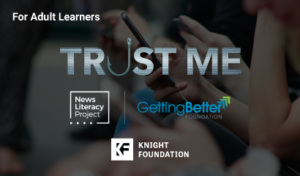 About the film
About the film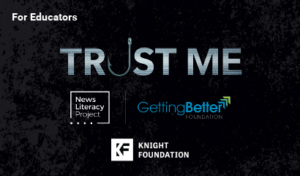 About the film
About the film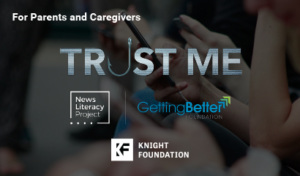 About the film
About the film